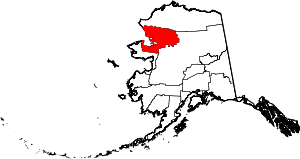Noorvik, Alaska
| Noorvik Nuurvik | |
|---|---|
| City | |
 Location in Northwest Arctic Borough and the state of Alaska. | |
| Coordinates: 66°50′14″N 161°2′12″W / 66.83722°N 161.03667°WCoordinates: 66°50′14″N 161°2′12″W / 66.83722°N 161.03667°W | |
| Country | United States |
| State | Alaska |
| Borough | Northwest Arctic |
| Incorporated | March 11, 1964[1] |
| Government | |
| • Mayor | Robert "Bobby" Welles |
| • State senator | Donny Olson (D) |
| • State rep. | Benjamin Nageak (D) |
| Area | |
| • Total | 1.3 sq mi (3.5 km2) |
| • Land | 1.0 sq mi (2.5 km2) |
| • Water | 0.4 sq mi (1.0 km2) |
| Elevation | 0 ft (0 m) |
| Population (2010)[2] | |
| • Total | 668 |
| • Density | 510/sq mi (190/km2) |
| Time zone | Alaska (AKST) (UTC-9) |
| • Summer (DST) | AKDT (UTC-8) |
| ZIP code | 99763 |
| Area code | 907 |
| FIPS code | 02-55140 |

Noorvik (Nuurvik in Iñupiaq) is a primarily Inupiat city in the Northwest Arctic Borough in the U.S. state of Alaska. As of the 2010 census, the population of the city was 668. Located in the NANA Region Corp, Noorvik has close ties with the largest city in the region, Kotzebue. Residents speak a dialect of Inupiaq known as Noorvik Inupiaq. Noorvik was the first town to be counted in the 2010 census.[3]
Geography

Noorvik is located at 66°50′14″N 161°2′12″W / 66.83722°N 161.03667°W (66.837130, -161.036641).[4]
Noorvik is located on the right bank of the Nazuruk Channel of the Kobuk River, 76 km (47 mi) east of Kotzebue.
According to the United States Census Bureau, the city has a total area of 1.3 square miles (3.4 km2), of which, 1.0 square mile (2.6 km2) of it is land and 0.4 square miles (1.0 km2) of it (28.36%) is water.
Demographics
| Historical population | |||
|---|---|---|---|
| Census | Pop. | %± | |
| 1920 | 281 | — | |
| 1930 | 198 | −29.5% | |
| 1940 | 211 | 6.6% | |
| 1950 | 248 | 17.5% | |
| 1960 | 384 | 54.8% | |
| 1970 | 462 | 20.3% | |
| 1980 | 492 | 6.5% | |
| 1990 | 531 | 7.9% | |
| 2000 | 634 | 19.4% | |
| 2010 | 668 | 5.4% | |
| Est. 2015 | 694 | [5] | 3.9% |
As of the census[7] of 2000, there were 634 people, 136 households, and 113 families residing in the city. The population density was 658.7 people per square mile (255.0/km²). There were 157 housing units at an average density of 163.1 per square mile (63.1/km²). The racial makeup of the city was 4.89% White, 90.06% Native American, 4.89% from two or more races, and 0.16% Pacific Islander.
There were 136 households out of which 58.1% had children under the age of 18 living with them, 51.5% were married couples living together, 18.4% had a female householder with no husband present, and 16.9% were non-families. 14.7% of all households were made up of individuals and 1.5% had someone living alone who was 65 years of age or older. The average household size was 4.66 and the average family size was 5.19.
In the city the age distribution of the population shows 44.5% under the age of 18, 10.6% from 18 to 24, 26.2% from 25 to 44, 11.5% from 45 to 64, and 7.3% who were 65 years of age or older. The median age was 21 years. For every 100 females there were 135.7 males. For every 100 females age 18 and over, there were 134.7 males.
The median income for a household in the city was $51,964, and the median income for a family was $52,708. Males had a median income of $34,750 versus $24,583 for females. The per capita income for the city was $12,020. About 9.4% of families and 7.6% of the population were below the poverty line, including 8.6% of those under age 18 and 3.8% of those age 65 or over.
History
Noorvik means "a place that is moved to" in Inupiaq. The village was established by Kowagmuit Inupiat fishermen and hunters from Deering in the early 1900s. Other settlers came from Oksik, a few miles upriver.
References
- ↑ 1996 Alaska Municipal Officials Directory. Juneau: Alaska Municipal League/Alaska Department of Community and Regional Affairs. January 1996. p. 108.
- ↑ "2010 City Population and Housing Occupancy Status". U.S. Census Bureau. Retrieved May 14, 2012.
- ↑ The Associated Press. 2010 census to start in remote Alaska village. Anchorage Daily News. July 31, 2009.
- ↑ "US Gazetteer files: 2010, 2000, and 1990". United States Census Bureau. 2011-02-12. Retrieved 2011-04-23.
- ↑ "Annual Estimates of the Resident Population for Incorporated Places: April 1, 2010 to July 1, 2015". Retrieved July 2, 2016.
- ↑ "Census of Population and Housing". Census.gov. Retrieved June 4, 2015.
- ↑ "American FactFinder". United States Census Bureau. Retrieved 2008-01-31.
External links
- Subsistence wildlife harvests in five northwest Alaska communities, 2001-2003 : results of a household survey / by Kawerak, Inc., Maniilaq Association, and the Alaska Department of Fish and Game ; by Susan Georgette ... [et al.]. Hosted by Alaska State Publications Program.
